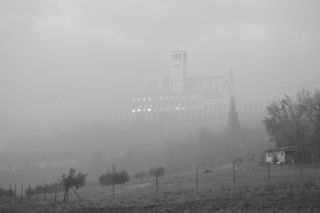Read a few books about St. Francis in the last few days. These were books I owned for many many years, just waiting for the occasion to be picked out of the bookcase and finally read. Helene Nolthenius is a Dutch historian who wrote a delightful book about St Francis towards the end of her life. She first translated about 100 pages of original sources describing what was going on in St Francis’ lifetime. Then 100 pages about St Francis in original sources and then 100 pages of interpretation.
Of course St Francis was a little bit of a fanatic. After wasting his teenager years with parties and chasing women, he saw the light and became an advocate of complete chastity and complete poverty. He would not look at women anymore and would not touch money. Someone threw a gold coin into the place were he stayed overnight. St Francis thought that the devil himself had entered his cell and wanted to throw the coin out. That is not so easy when you cannot touch the coin. He tried to use a stick of wood, but couldn’t get the coin out of the door.
Later (more than 24 hours) the guy who threw the coin in the cell and found an exhausted St Francis still struggling to remove the Devil. What are you doing the guy asked. ‘Don’t you see, the devil has visited my cell. The coin represents everything that has gone wrong in the world. It is the cause for every major conflict and war.’ The guy was more than happy to help St Francis on the condition that the soon to be saint would still pray for him.
But he was also full of joy, the reason why he is so popular still. He would always sing, he would preach to birds, and he disapproved of complaining. According to Jacques Le Goff, who wrote an even better book than Nolthenius about St Francis, St Francis is the reason that Italian Catholicism is so much more happy and jolly than that in Spain, France or Southern Germany.
He loved nature, that’s for sure. I guess he just loved life (except for women – he couldn’t help thinking about them, with staggering consequences. Luckily those thoughts came most often in the winter, when there was always an ice-cold mountain stream nearby to cure him of those kind of thoughts!).
He was a poet, with The canticle of the Creatures as his most famous poem/song (Het Zonnelied)
…
Praised be You, my Lord, with all Your creatures
Especially Sir Brother Sunday
…
And he is beautiful and radiant with great splendor
And then comes Sister Moon and the Stars, Brother Wind, Sister Water, Brother Fire, Sister Mother Earth (?), Those who give pardon (probably male) and Sister Bodily Death. And the Lord is praised for each and everyone of these. Wonder why we do not hear that song more often.
The focus on poverty pretty soon disappeared from the order. The extravagant Basilica above St. Francis’ tomb was built within fifteen years of his death. It shows the history of monasticism. To be successful, one has to preach poverty. The more honest and truthful one is, the richer one will be. Try to solve that one.



Leave a Reply